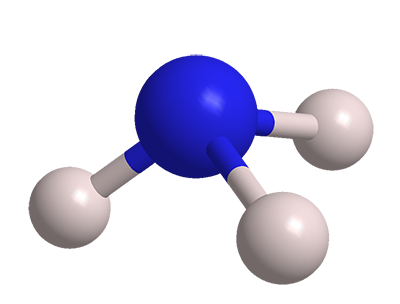What molecule am I?


Ammonia is a colorless, poisonous gas with a familiar noxious odor. It occurs in nature, primarily produced by anaerobic decay of plant and animal matter; and it also has been detected in outer space. Some plants, mainly legumes, in combination with rhizobia bacteria, “fix” atmospheric nitrogen to produce ammonia.
Ammonia has been known by its odor since ancient times. It was isolated in the 18th century by notable chemists Joseph Black (Scotland), Peter Woulfe (Ireland), Carl Wilhelm Scheele (Sweden/Germany), and Joseph Priestley (England). In 1785, French chemist Claude Louis Berthollet determined its elemental composition.
Ammonia is produced commercially via the catalytic reaction of nitrogen and hydrogen at high temperature and pressure. The process was developed in 1909 by German chemists Fritz Haber and Carl Bosch. Both received the Nobel Prize in Chemistry for their work, but in widely separated years: Haber in 1918 and Bosch in 1931. The fundamental Haber–Bosch process is still in use today.
In 2020, the worldwide ammonia production capacity was 224 million tonnes (Mt). Actual production was 187 Mt. It ranks ninth among chemicals produced globally.
Most ammonia production—≈85%—is used directly or indirectly in agriculture. Chemical fertilizers made from ammonia include urea, ammonium phosphate, ammonium nitrate, and other nitrates. Other important chemicals produced from ammonia include nitric acid, hydrazine, cyanides, and amino acids.
Ammonia was once used widely as a refrigerant. It has largely been displaced by chlorofluorocarbons and hydrochlorofluorocarbons, which are also under environmental scrutiny. Probably the most familiar household use of ammonia is in glass cleaners.
Ammonia is highly soluble in water; its exact solubility depends on temperature (see fast facts). Aqueous ammonia is also called ammonium hydroxide, but that molecule cannot be isolated. When ammonia is used as a ligand in coordination complexes, it is called “ammine”.
Currently ammonia is made from fossil fuel–derived hydrogen and is therefore not a “green” product, despite its widespread use in agriculture. But environmentally green ammonia may be on the horizon if the hydrogen is made by other means, such as wind- or solar-powered electrolysis of water.
Ammonia can be burned as a fuel in standard engines. A study by the catalyst company Haldor Topsoe (Kongens Lyngby, Denmark) concluded that replacing conventional ship fuels with green ammonia would be cost-efficient and would eliminate a significant source of greenhouse gases. It potentially can be used in aircraft fuels as well. During a transition period, ammonia could be mixed with conventional fuels.
Ammonia hazard information
| Hazard class* | Hazard statement | |
|---|---|---|
| Gases under pressure, liquefied gas | H280—Contains gas under pressure; may explode if heated | |
| Skin corrosion/irritation, category 1B | H314—Causes severe skin burns | |
| Serious eye damage/eye irritation, category 1 | H318—Causes serious eye damage | |
| Acute toxicity, inhalation, category 3 | H331—Toxic if inhaled | |
| Hazardous to the aquatic environment, acute hazard, category 1 | H400—Very toxic to aquatic life | |
| Hazardous to the aquatic environment, long-term hazard, category 2 | H411—Toxic to aquatic life with long-lasting effects | |
*Globally Harmonized System of Classification and Labeling of Chemicals. Explanation of pictograms.
MOTW update
L-Tryptophan was the Molecule of the Week for November 20, 2017. It is an essential amino acid that must be part of the human diet. Among other functions, it enables the body to synthesize serotonin and melatonin. Recently, tryptophan appeared in two biochemical studies.
In one, researchers at Pennsylvania State University (University Park) and the Massachusetts Institute of Technology (Cambridge) discovered that the enzyme tryptophan 2C methyltransferase, which catalyzes the addition of a methyl group to tryptophan’s indole ring in the synthesis of the antibiotic thiostrepton, does not use a radical mechanism as do most enzymes in its class. Instead, a carboxylate group in the enzyme acts as a general base to deprotonate the tryptophan substrate.
In the second study, A. Keith Dunker at Indiana University (Bloomington) and Klára Hlouchová at Charles University (Prague) collaborated in a quest to discover how life on Earth began. They hypothesized that inherently disordered proteins (IDPs), ones that don’t hold to a specific conformation, but move around, were involved early in the process. They believe that the unstructured proteins formed by IDPs were eventually augmented by the later-forming aromatic amino acids tryptophan and tyrosine, which are larger and give proteins a greater degree of structure. They tested their ideas by replacing the aromatic amino acids in a key enzyme with leucine; the modified, less structured enzyme retained some activity, but ultimately failed to perform as efficiently as the original.
MOTW update: March 15, 2021
Ammonia's main use is in agriculture, but now it may have a “greener” use—as a transportation fuel. This past week, an article in Chemical & Engineering News presented an industrial update of the options and obstacles that will determine whether ammonia is indeed the “fuel of the future”.
Ammonia fast facts
| CAS Reg. No. | 7664-41-7 |
| SciFinder nomenclature | Ammonia |
| Empirical formula | H3N |
| Molar mass | 17.03 g/mol |
| Appearance | Colorless gas |
| Boiling point | –33.3 ºC |
| Water solubility | ≈530 g/L (20 ºC) ≈320 g/L (25 ºC) |
MOTW update:
August 25, 2025
Nitric oxide1 (NO) and ammonia2 (NH3) were the Molecules of the Week for February 4, 2013, and February 8, 2021, respectively. Both are useful, but toxic, gases under standard conditions.
This month, Ying Qin, Junyun Gao, and Bo Huang* at Xi’an Jiaotong University (Xi’an) and Shaanxi Tianyi Element Technology Co. (Xianyang, both in China) described a high-yield process for converting NO to NH3 at ambient pressure and relatively low temperatures. They used a solid-solution OsxPt1–x/γ-Al2O3 catalyst at 200 °C to yield up to 97% NH3, a marked improvement over the traditional Haber–Bosch process.
1. CAS Reg. No. 10102-43-9.
2. CAS Reg. No. 7664-41-7.
MOTW update: September 11, 2023
Ammonia1, a colorless, toxic gas, is an important industrial and agricultural chemical and a starting material for making a host of other compounds. It was the topic of two literature reports in August.
The city of Beijing has chronically poor air quality. Yixin Guo, Lin Zhang, and coauthors at Peking University (Beijing) and other Chinese research institutions contend that the pollution may be even worse than previously thought. They found that summertime ammonia emissions are substantially underestimated in Beijing because the prevailing atmospheric models do not completely account for sources such as fertilizer, power plants, vehicle traffic, and residences.
In contrast, Ronny Neumann and collaborators at the Weizmann Institute of Science (Rehovot, Israel) and the University of Rovira i Virgili (Tarragona, Spain) developed a way to make ammonia from molecular nitrogen and water. This finding eliminates the coproduction of carbon dioxide, which occurs when ammonia is made from hydrogen derived from fossil fuel sources such as natural gas. The researchers’ electrolytic process is catalyzed by a tri-iron–substituted polyoxotungstate, {SiFe3W9}, in the presence of lithium or sodium cations. Water acts as both a proton and electron donor.
1. CAS Reg. No. 7664-41-7.

Learn more about this molecule from CAS, the most authoritative and comprehensive source for chemical information.
Molecule of the Week needs your suggestions!
If your favorite molecule is not in our archive, please send us a message. The molecule can be notable for its current or historical importance or for any quirky reason. Thank you!
Stay Ahead of the Chemistry Curve
Learn how ACS can help you stay ahead in the world of chemistry.

